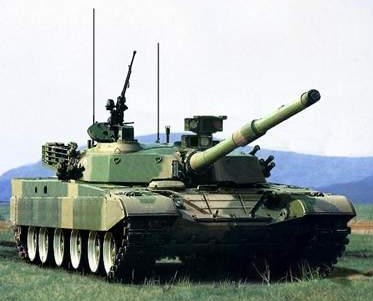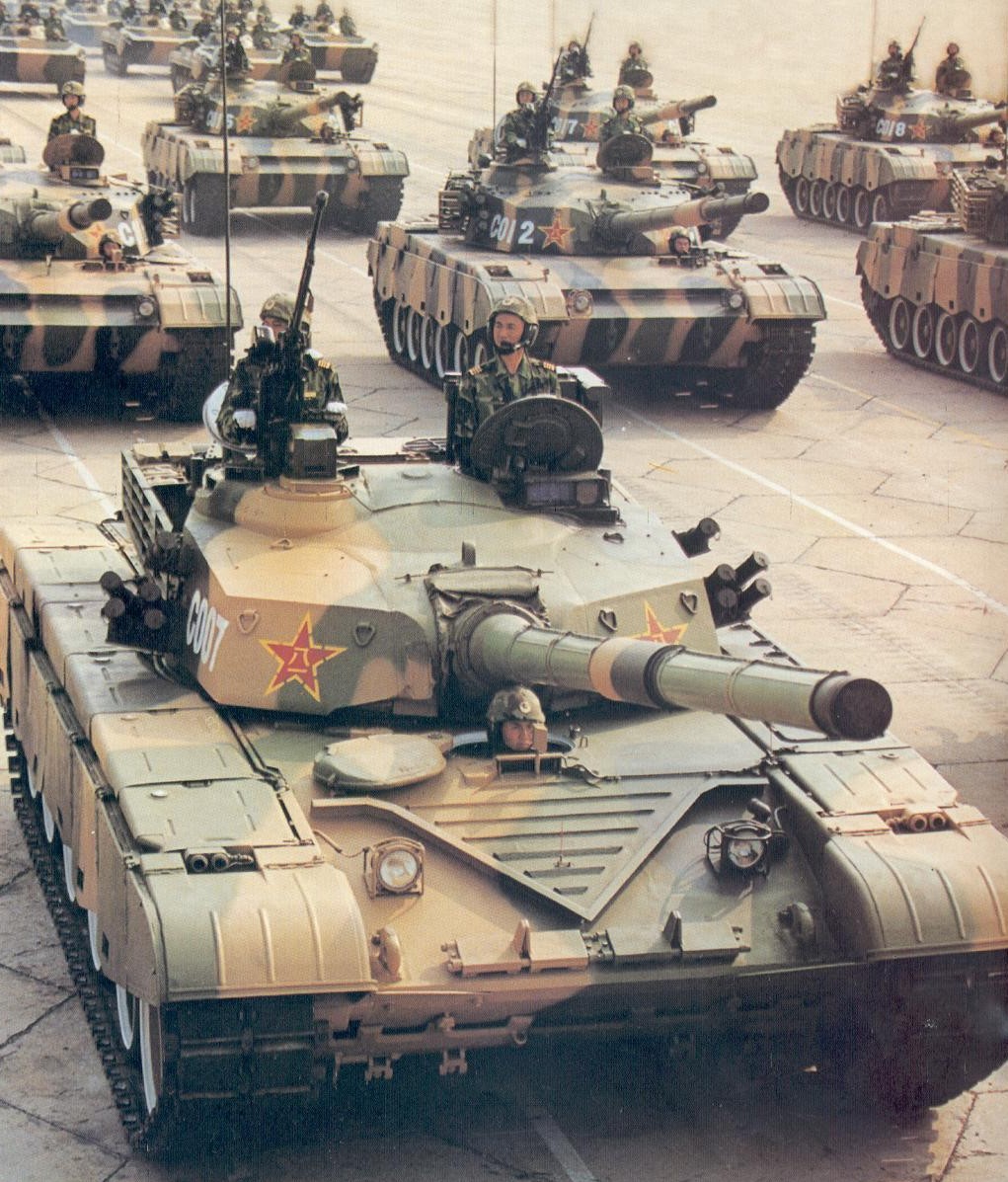 China's
New Tanks.
China's
New Tanks.
 Meet
China's new Type 98 MBT. This is a tank that has been under constant
development since the late 1980's. The project started out with something
called the Type 2000, a Tank destined for export to Pakistan under contract.
Early versions were deemed unfit for service in China's war machine... but that
has changed. Some items to note, the hull. This appears to be a
development of the Russian T-80 MBT, a very formidable and fast platform...
probably easily one of the best tanks in the world next to the Abrams, Merkava,
and Leopard. Perhaps the most interesting characteristic of the Type 98 is the
addition of what appears to be a previously unknown active self-defense system.
Unlike contemporary Russian active tank self-defense systems like Drozd,
Drozd-2, and Arena, which launch projectiles to disable or "shoot-down" incoming
anti-tank missiles and projectiles, the Chinese system apparently uses a
high-powered laser to directly attack the enemy weapon's optics and gunner. The
system includes what appears to be a laser warning receiver (LWR - the
dome-shaped device on the turret roof behind the commander's position), that
warns the crew that their tank is being illuminated by an enemy range-finding or
weapon-guidance laser. The turret of the tank can then be traversed to face the
direction of the enemy threat, and the laser self-defense weapon (LSDW - the
box-shaped device on the turret roof behind the gunner's position), can be
employed against the source of the enemy laser. While the engagement procedure
of the Type 98's self-defense laser is unknown, published reports concerning
similar weapons describe a procedure where the laser weapon would first use a
low-powered beam to locate the optics of the enemy weapon. Once the enemy weapon
was located, the power level of the laser would be immediately and dramatically
increased. Such an attack would disable the guidance optics of the enemy weapon
and/or damage the eyesight of the enemy gunner. The turret-mounted system
carried by the Type 98 is very similar to a tripod-mounted laser weapon that was
seen for the first time at an arms exhibition in Manila in 1995. Identified at
the exhibition as the "Laser Interference Device," it matched the description of
a known Chinese laser weapon called the ZM-87. According to its promotional
information, one of the ZM-87's major uses is to "injure or dizzy targeted
individuals." The ZM-87 can reportedly injure the human eye at 2-3 kms, this
rising to over 5 kms using a 7-power magnification device. Additionally,
short-term "flaring blind-ness" can be inflicted on the human eye at up to 10
kms. The ZM-87 and the laser weapon carried by the Type 98 should not be
confused with electro-optical "dazzlers" like those turret-mounted de-vices used
by the Iraqis during Operation Desert Storm. Those Iraqi devices (some of which
are believed to have been supplied by the Chinese), are designed to confuse the
tracking systems of Western/NATO anti-tank guided missiles (ATGMs), without
directly attacking the controlling optics or the eyesight of the weapon's
gunner. The available photos of the Type 96 have also confirmed that the laser
weapon can be elevated to a higher angle than the tank's main gun, indicating
that the engagement of attack helicopters is possible.
Meet
China's new Type 98 MBT. This is a tank that has been under constant
development since the late 1980's. The project started out with something
called the Type 2000, a Tank destined for export to Pakistan under contract.
Early versions were deemed unfit for service in China's war machine... but that
has changed. Some items to note, the hull. This appears to be a
development of the Russian T-80 MBT, a very formidable and fast platform...
probably easily one of the best tanks in the world next to the Abrams, Merkava,
and Leopard. Perhaps the most interesting characteristic of the Type 98 is the
addition of what appears to be a previously unknown active self-defense system.
Unlike contemporary Russian active tank self-defense systems like Drozd,
Drozd-2, and Arena, which launch projectiles to disable or "shoot-down" incoming
anti-tank missiles and projectiles, the Chinese system apparently uses a
high-powered laser to directly attack the enemy weapon's optics and gunner. The
system includes what appears to be a laser warning receiver (LWR - the
dome-shaped device on the turret roof behind the commander's position), that
warns the crew that their tank is being illuminated by an enemy range-finding or
weapon-guidance laser. The turret of the tank can then be traversed to face the
direction of the enemy threat, and the laser self-defense weapon (LSDW - the
box-shaped device on the turret roof behind the gunner's position), can be
employed against the source of the enemy laser. While the engagement procedure
of the Type 98's self-defense laser is unknown, published reports concerning
similar weapons describe a procedure where the laser weapon would first use a
low-powered beam to locate the optics of the enemy weapon. Once the enemy weapon
was located, the power level of the laser would be immediately and dramatically
increased. Such an attack would disable the guidance optics of the enemy weapon
and/or damage the eyesight of the enemy gunner. The turret-mounted system
carried by the Type 98 is very similar to a tripod-mounted laser weapon that was
seen for the first time at an arms exhibition in Manila in 1995. Identified at
the exhibition as the "Laser Interference Device," it matched the description of
a known Chinese laser weapon called the ZM-87. According to its promotional
information, one of the ZM-87's major uses is to "injure or dizzy targeted
individuals." The ZM-87 can reportedly injure the human eye at 2-3 kms, this
rising to over 5 kms using a 7-power magnification device. Additionally,
short-term "flaring blind-ness" can be inflicted on the human eye at up to 10
kms. The ZM-87 and the laser weapon carried by the Type 98 should not be
confused with electro-optical "dazzlers" like those turret-mounted de-vices used
by the Iraqis during Operation Desert Storm. Those Iraqi devices (some of which
are believed to have been supplied by the Chinese), are designed to confuse the
tracking systems of Western/NATO anti-tank guided missiles (ATGMs), without
directly attacking the controlling optics or the eyesight of the weapon's
gunner. The available photos of the Type 96 have also confirmed that the laser
weapon can be elevated to a higher angle than the tank's main gun, indicating
that the engagement of attack helicopters is possible.
The Type 98 reportedly
weighs 50 tons and is powered by a new 1200-hp diesel engine. As far as armor
protection is concerned, some initial observations can be made. Generally
speaking, the Type 98's turret is larger than the turrets of other PLA tanks.
More importantly, the turret has been lengthened or extended forward, creating a
noticeable gap between the lower edge of the turret-front and the hull decking.
This new gap is most visible just to the right and left of the driver's position
(see photo on top of next page). It is very likely that the Chinese decided to
increase/improve the turret frontal armor protecting the Type 98 to the point
where extending the turret forward became a requirement.
 While
details concerning the type and design of the Type 98's armor are lacking, there
is the possibility that its armor is based on, or influenced by, the Russian
T-80U MBT. When the PLA's relatively recent purchase of Russian T-80Us is
combined with what was learned during the parade, a Russian armor connection is
certainly possible. Like the T-80U, the Type 98 incorporates turret frontal
armor cavities (one on either side of the main gun - clearly visible when viewed
from above), covered by plates which are fitted flush and bolted to the turret
roof. The purpose of these cavities may be to allow the composite contents of
each cavity to be easily upgraded and changed during the life of the tank.
While
details concerning the type and design of the Type 98's armor are lacking, there
is the possibility that its armor is based on, or influenced by, the Russian
T-80U MBT. When the PLA's relatively recent purchase of Russian T-80Us is
combined with what was learned during the parade, a Russian armor connection is
certainly possible. Like the T-80U, the Type 98 incorporates turret frontal
armor cavities (one on either side of the main gun - clearly visible when viewed
from above), covered by plates which are fitted flush and bolted to the turret
roof. The purpose of these cavities may be to allow the composite contents of
each cavity to be easily upgraded and changed during the life of the tank.
The Type 98 is a
significant tank for the Chinese and for their potential adversaries. It
represents a modern heavy armor threat in an era where some countries seem to be
moving away from the proven mobile protected fire-power offered by the MBT. One
thing is clear, the Type 98 is a post-Desert Storm tank that incorporates the
lessons the Chinese learned from that conflict; lessons that will characterize
the next battlefield. As the U.S. Army turns its focus inward and reconsiders
the design of its own armored force, it could be a costly mistake to
underestimate the heavy threat represented by tanks like the Chinese Type 98 -
the Beast from the East.

